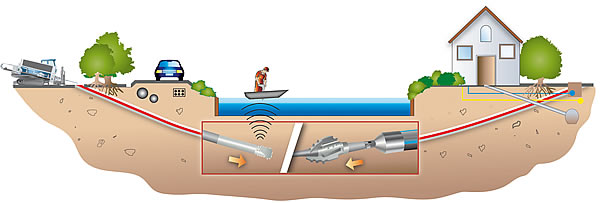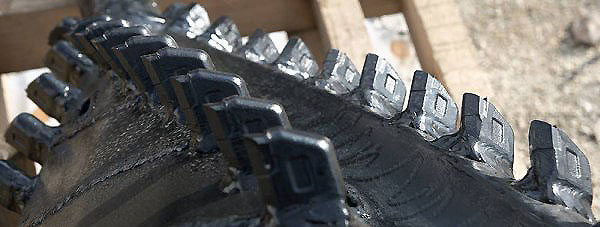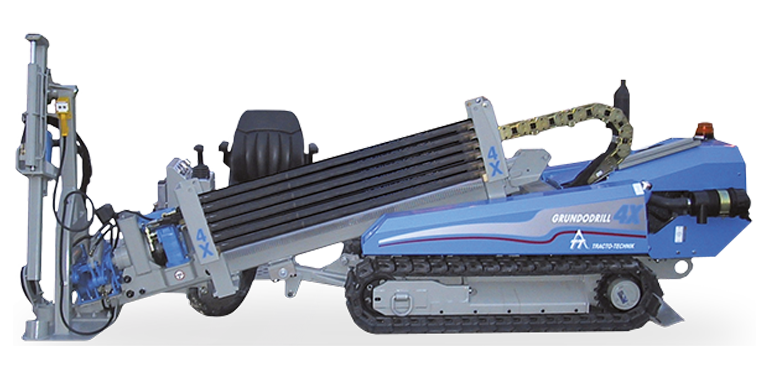A short description of the horizontal directional drilling (HDD) technology:
Directional drilling is one of the most effective and versatile technologies for laying down pipes without milling, and is a diversified solution in public utility construction. The essence of the method is to create the passage from the surface, without digging a working trench, then expand it to the desired diameter and insert the product pipe from the outgoing access point.
In the first phase of the work, the drill bit at the end of the flexible drill shank is thrust forward to prepare the pilot hole that follows the planned trail, along which the public utility pipeline will be installed in its final position.
The trail primarily depends on the parameters of the materials used (protective pipe and utility pipe) and the circumstances, considering that the minimum inflection radius of the drill shanks need to be between 25 and 140 m depending on the type of machinery.
Drilling is performed while rinsing with drilling fluid containing various additives mixed with water, emptied under high pressure from the drill bit through the nozzles, thereby assisting the progress and cooling the bit as well as supporting the borehole. Due to the rinsing, the drilling fluid and the extruded material needs to be collected, ideally by using a launching and a target mud pit.
Another crucial phase of directional drilling is the dilation phase.
Depending on the diameter of the pipe to be installed, this phase takes place in one or more steps where the drill bit is replaced by the appropriate dilation bit, after which it is pulled towards the initial point of the drilling, rotating around its shaft. When selecting the dilation bit, it is important to have a clear understanding of the soil structure to determine the type and size of the appropriate bit.
The last step is when the protective pipe, or directly the product pipe, gets pulled into the dilated and cleaned borehole.
The essence of directional drilling
We create the hole from the surface by drilling, without digging a working trench.

Dilation bit to expand the hole
The drill bit is replaced by the dilation bit.

Applying the horizontal directional drilling technology:
It is best applied in urban settings where public utilities are plenty and that has a great number of roads, railways, rivers, or other crossings where traditional methods for public utility construction involving milling cannot be implemented or only with great difficulty and with high expenses. This technology allows the underground installation of pipes under various objects (e.g., motorways, rivers, railway lines).
The technology does not require a launching and receiving mud pit (those are necessary only for collecting the drilling fluid). The timeline of the implementation is substantially shorter than with traditional methods.
Comparative cost analyses show that most tasks for public utility construction incur smaller costs in case of directional drilling than for other, traditional methods.
Drilling length and diameters greatly vary depending on the machinery and soil structure:
Applicable pipe diameter: Ø 32-1600 mm*
Applicable drilling length: ~5000 m*
* In case the theoretical limits of the technology, the unique equipment, and favourable circumstances allow.
To whom, when, and for what purposes is directional drilling recommended?
We always recommend to our clients the solution that best suits the problem, be it simple or complex, since Zolmat offers a wide selection of technology solutions.Directional drilling is used for the underground installation of the following public utility cables without surface milling:
Water pipeline | Sewage | Gas pipes | Heavy current cables | Communication cables
With the directional drilling technology we install a pipe, either made of steel or of flexible plastic (typically CPE), under the ground that will usually serve as a protective pipe, but naturally we can also install the product pipe directly.
Directional drilling may be required when the public utility pipe cannot be installed by the traditional trench method or by laying the pipe in the trench because:
- Installation is physically impossible (at the crossing of water surfaces, railway, buildings, etc.);
or when considering the following sensible aspects:
- The road operator would – quite rightly – refuse to authorise milling due to possible damages or disruption of a high quality, continuous pavements surface, or the milling would result in undue obstruction of traffic.
- In some cases, drilling may be cheaper than pipe laying (for example, for a 1.5-metre-wide pavement, the costs of pipe laying and subsequent professional asphalt work would be higher than drilling in 150-metre sections, not to mention the hindrances caused to residential traffic for several weeks. Drilling is even more economical, of course, in case of a more valuable pavement surface (e.g., decorative surfaces).
- For valuable foliage on the surface (such as irreplaceable veteran trees) and nice parks, directional drilling is the only viable option.
- For shorter drillings, cheaper drilling methods are often selected, such as a pneumatic rocket drill, extrusion drill, etc. However, these cannot be targeted, and are also very much dependant on the soil and cannot be used in case of very hard, littered or very soft ground. In such cases, directional drilling is always the successful solution in our experience.
- For pipe installations in case of larger straight pipes, a frequent practice is the so-called pipe jacking, either by jacking the steel pipe through by large force, or driven through the soil with a unique picker. This technology is very expensive, requires moving large masses of soil, and is very time consuming, while it is also dependant on the type of soil and is not suitable for targeting. For example, it is usually impossible to perform pipe jacking under groundwater. Directional drilling in such cases again proves to be an inexpensive, quick and simple alternative, where we can place even straight pipes at any depth underground.
Considering the above, we recommend our directional drilling technology to all who face the above issues in their work, that is:
- For those designing or implementing public utilities;
- For those who are authorised to issue milling permits: please consider, wouldn’t directional drilling be a better solution to the problem?

